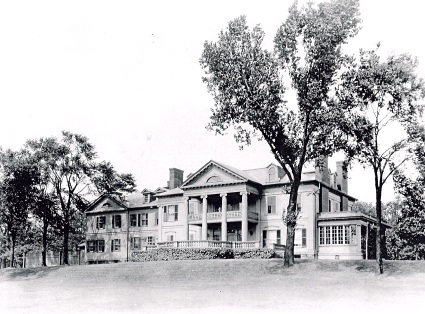
"Lost Grand Island"
Examples of structures that could have been saved with a local preservation ordinance.

This magnificent Georgian home was built by Franklin and Charlotte Spaulding Sidway. Overlooking the Niagara River, the house became the center piece of "River Lawn," once the estate of Elbridge Gerry Spaulding. Upon the death of E. G. Spaulding in May of 1897, the three hundred and fifty acre estate passed to his daughter, Charlotte. The house and most of the out buildings, which dotted the estate, were destroyed when "River Lawn" became part of Beaver Island State Park. (From a collection of photos taken 4/29/32 by Hare Photography Studios)
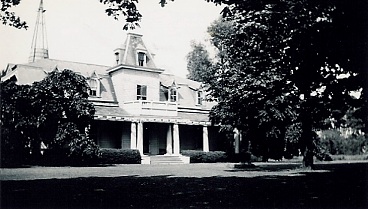
The Beaver Island Club was built on Beaver Island, the small island off the head of Grand Island, in 1852. The club, originally known as the Jolly Reefers, was made up of a group of Buffalo sportsmen, including Grover Cleveland, who enjoyed fishing the area. Charter member Charles D. Marshall eventually purchased the impressive looking club house and 40 acres of land. Remodeled as his summer home, it was known for many years as the Marshall Mansion. The State of New York took over the property which became a part of Beaver Island State Park and the Beaver Island Club finally fell victim to progress in 1941. The Beaver Island Club was one of many elaborate clubs and summer homes built during the Island's Golden Era.
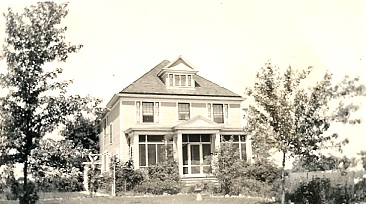
St. Stephen's Catholic Church buildings on Baseline Road, Grand Island date back to 1862. The first rectory was constructed and semi-completed in 1906 at a cost of $5,078 with most of the labor cost being contributed by members of the parish. Father Charles F. Kraehn, parish priest from 1906-1928, in a letter to Father Edward Schwegler in 1952 said, "I established residentia in the rectory of St. Stephen's Church early in 1925 after having spent the hectic years from 1916 to 1925 commuting on Sundays via ferry." The rectory was then made a comfortable residence when it was papered, floors were finished, and wiring for electricity, water, bath, and a heating plant were installed. Sadly, the house was torn down in 1993.
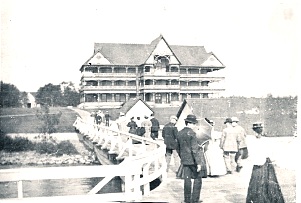
Grand Island's Golden Era took place in the later 1800s and early 1900s when it blossomed as a town of clubs, hotels and mansions. The Oakfield Club located on the west shore and upriver from the Falconwood Club, was the largest private club on the Island, at one time boasting a membership of 400. Accounts of its origin differ. One mention lists its founding as 1873, however it is shown on a Grand Island Map of 1865. It consisted of this main clubhouse, surrounded by private guest houses, a large boathouse and dock side bar. The three-story clubhouse, destroyed by fire in the 1890s, was replaced with a two-story wooden structure, nearly 80 feet in length and surrounded by a columned veranda. Though completely remodeled and not recognizable, it is still located on West Oakfield Road today.
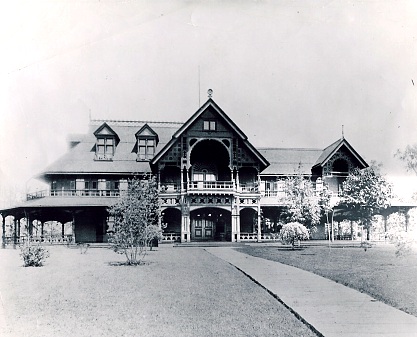
Declared a township in 1852, Grand Island in the half century that followed, changed from mainly farming country to an era that included exclusive clubs and elaborate summer homes. Lewis F. Allen's Falconwood Club opened as a resort on June 19, 1858. Its design was of the "villa" order or what would later be known as "Queen Anne." Located on 45 acres overlooking the West River on Grand Island, its twelve foot verandahs ran the full length of the site that boasted an elegant bar, bowling alley, assembly hall and a number of guest rooms. Its wharf projected 110 feet into the river. The Falconwood Club burned in the 1920s.
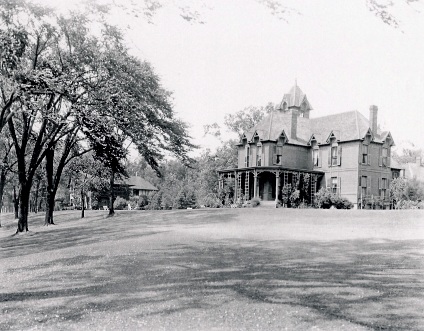
Elbridge Gerry Spaulding built this Victorian era Stick Style home about 1870 as his summer retreat on Grand Island. "River Lawn," as the estate was called, had a half mile of river front and encompassed 350 acres of broad woodlands and cultivated fields. It was in this setting that E. G. Spaulding indulged his hobby of raising some of the finest cattle in the nation. During the 1930s, the estate became part of Beaver Island State Park. In this photo the Ralph Sidway House, now the park office, may be seen on the left.
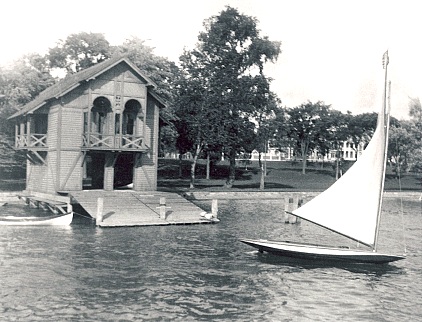
A circa 1903 photo of the Spaulding-Sidway Boathouse in its original setting on the river front of "River Lawn." Built circa 1870 by Elbridge Gerry Spaulding in the late Victorian Stick Style, the boathouse is architecturally and historically significant as a rare and outstanding example of a late 19th century recreational structure. In 1935, when "River Lawn" became part of Beaver Island State Park, the boathouse was floated up river to its present site by Franklin St. John Sidway, E. G. Spaulding's grandson. The boathouse was listed on the National Register of Historic Places in July of 1998. (from a book of photographs titled "River Lawn" produced by Bliss Brothers Photographers and dated 1903).
Historic Preservation on Grand Island
This website is sponsored by
GIECOM.NET
1871 Whitehaven Road, Grand Island, New York, 14072-1803 USA
Copyright © 1995-2013 All rights reserved.